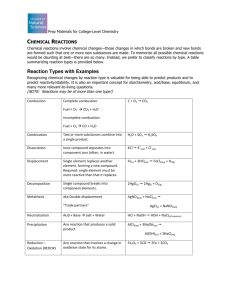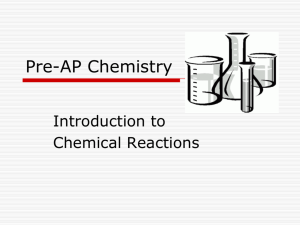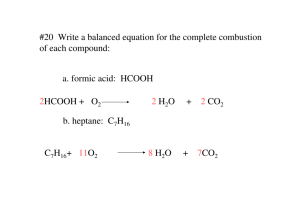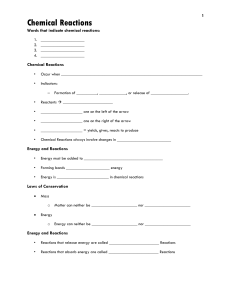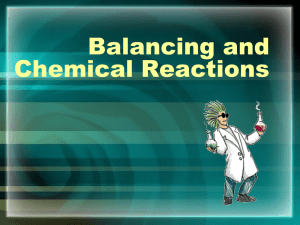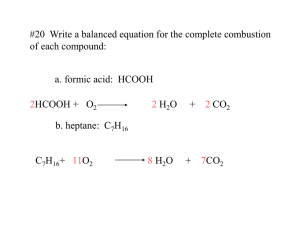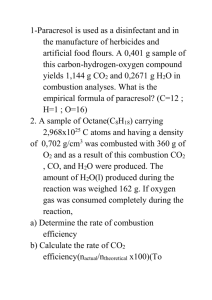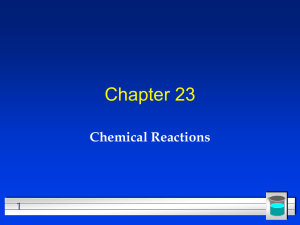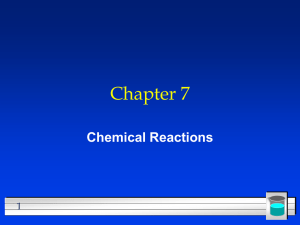Document
advertisement
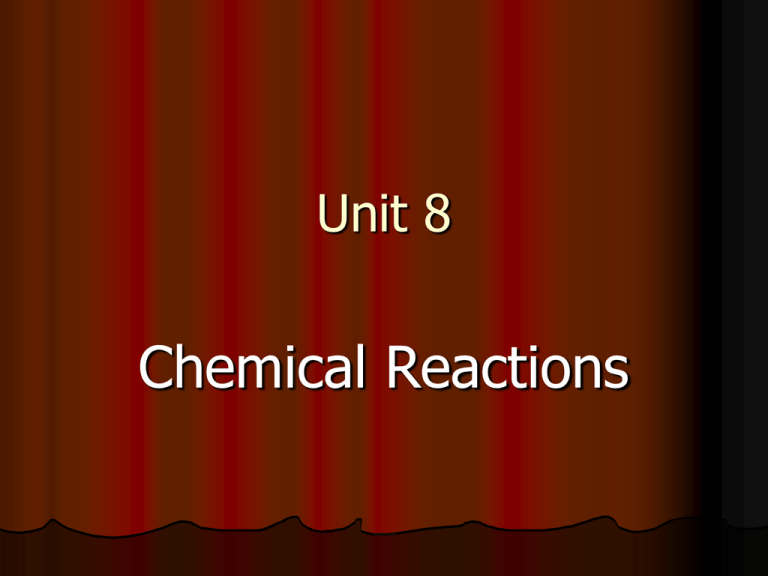
Unit 8 Chemical Reactions What is a Chemical Reaction? When a substance is changed into another substance by chemical means Reactants = what you start with Products = what you end up with During a Chemical Reaction… Bonds are formed, broken, or both Atoms are rearranged, NOT created or destroyed Conservation of Atoms Law of Conservation of Mass Evidence of Chemical Reactions Evolution/production of a gas Bubbling or odor change Forming a precipitate Two clear solutions cloudy/particles Release or absorb energy Change temperature or give off light Color change in reaction system Writing Chemical Equations Reactants Products HC2H3O2 + NaHCO3 NaC2H3O2 + H2O + CO2 Can also include info about state of matter s = solid l= liquid g = gas aq = aqueous solution (water solution) HC2H3O2 (aq) + NaHCO3 (s) NaC2H3O2 (aq)+ H2O (l) + CO2 (g) Writing Chemical Reactions Pt is used to indicate a catalyst used in the reaction (in this case, it’s platinum) What is a catalyst? A substance that speeds up a reaction without being changed by the reaction. Enzymes are biological catalysts. Writing Chemical Reactions Word Equations – replaces symbols and formulas with names Cu + Cl CuCl2 Copper + chlorine copper (II) chloride Fe + O2 Fe2O3 Iron + Oxygen → Iron (III) oxide Balancing Chemical Equations Balancing Equations Law of Conservation of Mass Mass of products = Mass of reactants Atoms can’t be created or destroyed A balanced equation has the same number of atoms of each element on both sides of the equation. C + O O O C C + O2 CO2 Start with 1 carbon, 2 oxygens End with 1 carbon, 2 oxygens This equation is already balanced O C + O O C O C + O2 CO We need one more oxygen in the products. We can’t change the formula, because it describes what actually happens C + O O C O The O must be used to make another CO But where did the other C come from? Must have started with two C Balanced equation = 2 C + O2 2 CO Rules for balancing Write the correct formulas for all the reactants and products Count the number of atoms of each type appearing on both sides Balance the elements one at a time by adding coefficients (the numbers in front) Check to make sure it is balanced. Never… Change a subscript to balance an equation. If you change the formula you are describing a different reaction. H2O is a different compound than H2O2 Put a coefficient in the middle of a formula 2 NaCl is okay, Na2Cl is not. How do I balance an equation? Start with elements that only appear once on each side. CH4 + O2 CO2 + H2O If an atom appears more than once on a side, balance it last. CH4 + O2 CO2 + H2O Example 2 H2 + O2 H22H O2O R P 4 2 H 2 4 2 O 1 2 The equation Make Changes Also Need Recount changes twice a table theasO to is the much keep balanced, HH O track in the has of where product reactant the same you number are at of each kind of atom on both sides Example 2 H2 + O2 2 H2O R P 4 2 H 2 4 2 O 1 2 This is the answer Not this Example N2 + H2 NH3 Examples P+ O2 P4O10 Examples Al + N2 Al2N3 Examples CH4 + O2 CO2 + H2O Examples AgNO3 + Cu Cu(NO3)2 + Ag Examples Na + H2O H2 + NaOH Examples AgNO3 + H2S → Ag2S + HNO3 Word Equations Iron (III) chloride + calcium hydroxide → Iron (III) hydroxide + calcium chloride FeCl3 + Ca(OH)2 → Fe(OH)3 + CaCl2 Types of Chemical Rxns Synthesis: 2 things combine to form 1 R + S → RS Decomposition: 1 thing breaks down to form 2 or more products RS → R + S Types of Chemical Rxns Single-Replacement: 1 element replaces a single element in a compound T + RS → TS + R Double-Replacement: 2 elements (ions) switch RS + TU → RU + TS Combustion Rxn: must have O2 as a reactant. Ex. 2C8H18 + 25O2 → 16CO2 + 18H2O Synthesis Reactions 2 elements or compounds combine to make 1 compound 2Ca +O2 CaO SO3 + H2O H2SO4 We can predict the products if there are two elements as reactants Mg + N2 MgN Mg + N2 Mg3N2 Write and balance Al + O2 First step - write the formula Next – balance the equation Write and balance Ca + Cl2 Write and balance Fe + O2 Decomposition Reactions One reactant breaks apart into two or more elements or compounds electricity NaCl Na + Cl2 CaCO3 CaO + CO2 Decomposition Reactions We can predict the products if the reactant is a binary compound Binary compound = Made up of only two elements electricity H2O H2 + O2 Decomposition Reactions HgO Decomposition Reactions If the reactant compound has more than two elements, you must be given one of the products The other product will be from the missing pieces NiCO3 NiO + C Single Replacement One element replaces another Reactants must be an element and a compound. Products will be a different element and a different compound. Na + KCl K + NaCl F2 + LiCl LiF + Cl2 Single Replacement Metals replace metals (and hydrogen) Al + CuSO4 Zn + H2SO4 Water - Think of water as HOH Metals replace one of the H to combine with hydroxide Na + H2O Na + HOH Single Replacement When it comes to metals, we can actually predict whether a reaction is possible Some metals are more active than others More active replaces less active but not vice versa Can replace an element below it, but not above it on this list. Single Replacement Al + HCl Single Replacement Fe + CuSO4 Single Replacement Pb + KCl Single Replacement Nonmetals can replace other nonmetals F2 + HCl Br2 + KCl F2 + 2 LiCl 2 LiF + Cl2 F Li Cl Li Cl F Na + KCl K + NaCl Na K Cl Double Replacement Two things replace each other Reactants must be two ionic compounds or acids NaOH + FeCl3 The positive ions change place. NaOH + FeCl3 Fe3+OH- + Na+Cl NaOH + FeCl3 Fe(OH)3 + NaCl 3NaOH + FeCl3 Fe(OH)3 + 3NaCl Na+ O- H+ Cl- Na+ O- H+ Cl- Fe3+ Cl- Na+ O- H+ Complete and balance Assume all of the reactions are possible CaCl2 + NaOH CuCl2 + K2S Complete and balance KOH + Fe(NO3)3 H3PO4 + Ca(OH)2 Combustion Reactions A compound composed of only C, H, and maybe O is reacted with oxygen Composed of C & H = hydrocarbon O2 will always be the second reactant If the combustion is complete, the products will be CO2 and H2O If the combustion is incomplete, the products will be C, CO, & H2O Examples Complete combustion of C4H10 Incomplete combustion of C4H10 Examples Complete combustion of C6H12O6 Incomplete combustion of C2H6O
